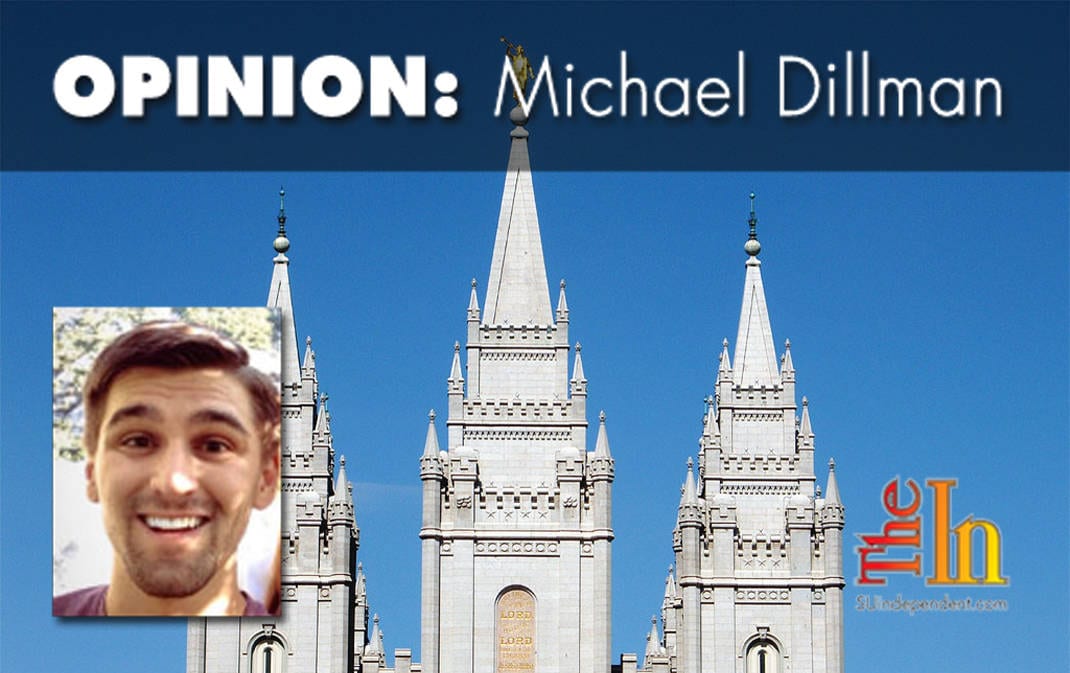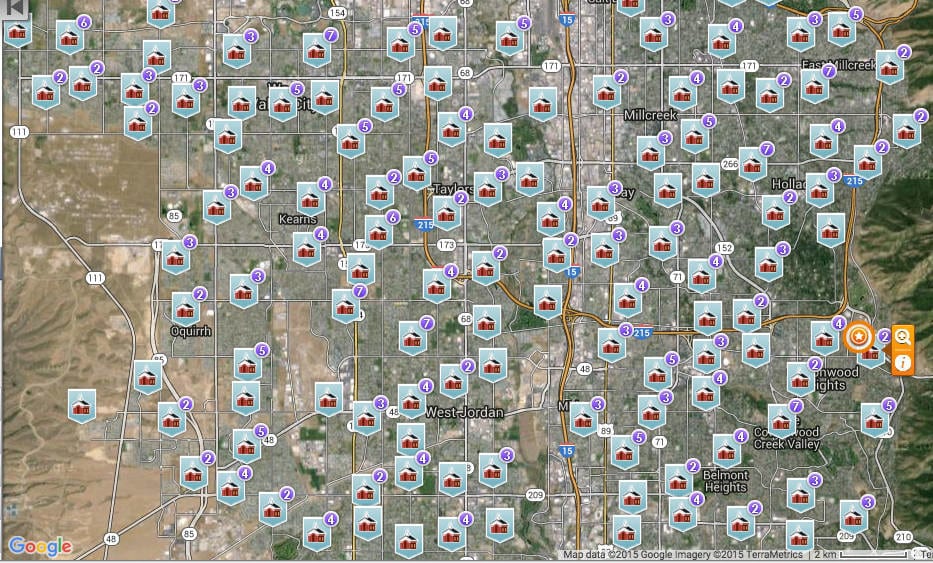
At a Rocky Mountain Power regional meeting at the Rio Tinto Stadium on Oct. 5, Cindy Crane, president of Rocky Mountain Power, gave The Church of Jesus Christ of Latter-day Saints an award for energy conservation. Rocky Mountain Power provided the church with $2 million in incentives through the program for their efforts to save energy.
According to Rocky Mountain power, the Church has only saved 1 million kilowatt hours so far this year. When you add up the cost of water for landscaping, heating super-sized structures in the Utah winters, cooling those same structures in the hot Utah summers, and so on, the EIA calculator for energy consumption that I used estimated that $2 per square foot is spent on energy in a typical building that is the size and age of the average Mormon Church building.
Many of the faith’s over 170 temples exceed 100,000 sq. feet, and given the age and size of Salt Lake City temple (over 250,000 sq. feet), the estimate on annual energy consumption for that temple alone is in the high single-digit millions of kilowatt-hours annually. If the average Mormon meeting house is 10,000 square feet (a generous estimate for them), then each building likely uses about 61,000 kilowatt hours annually. Multiply that number by the 148 temples, 418 missions, 29,600 wards, and you’d have at least 200 million kilowatt hours burned annually.
Keep in mind, that figure doesn’t include the billions of dollars in real estate the institution owns across the world. Hardly award-winning material for aggregate energy reduction. The fact that only one LDS-owned building in the entire country has solar panels should be proof enough that they aren’t buying into the environmental movement.

In an effort to accurately gauge the environmental impact of the powerful LDS presence here in Utah, I visited The Mormon Church’s website, LDS.org, which has a mapping tool integrated into the website to assist people in finding a convenient meetinghouse anywhere in the world. Using that tool, you can find that, just in Salt Lake County, there is one LDS chapel for roughly every 1.3 square miles. It’s noteworthy that this county also includes mountains, state- or city-owned properties, deserts, wetlands, and other areas where building more neighborhoods and churches isn’t possible. Some simple division yields an astonishing fact: there is one Mormon meetinghouse for every 1,614 residents of any or no faith, not just Mormons. Utah County, a notoriously Mormon-dense community, has five locations where meetinghouses are close enough in proximity to be considered adjacent to one another, sometimes side-by-side or at 90-degree angles on the same plot of land.
One reason there are so many Mormon chapels is that Mormons tends to have smaller congregations than other monotheistic religions. Part-time bishops lead congregations, or “wards,” with relatively small groups of people coming to weekly meetings. Other faiths here in the United States tend to build cathedrals or meeting place structures for followers that are larger, or at least more full. The church’s website boasts 15.3 million members worldwide; however, it is estimated that only one-third are considered “active churchgoers” in the United States, and less than two percent are active in Mexico and South America. If you’re feeling generous and you’re willing to count the non-active members of the faith, Mormons still only make up about one percent of the U.S. population, and that figure is in decline.
Despite the Church’s comparatively small size, their vast financial portfolio yields the institution a disproportionate amount of power and responsibility. The organization’s most lucrative for-profit enterprise, Deseret Management Corporation (DMC), collects $1.2 billion in annual revenue. The subsidiaries of DMC own a consortium of an insurance company, 11 radio stations, a TV station, a publishing and distribution company, a newspaper, a digital media company, and other various businesses with assets totaling over $3.3 billion. And that’s just one of their many for-profit branches.
Other Church-owned assets expanding their wildly diversified investments include a 290,000-acre ranch in Florida (estimated at over $1 billion) that harbors not only 44,000 cows but also citrus, sod, and timber operations. The Church also runs several for-profit real estate agencies that own, develop, and manage malls, parking lots, office parks, residential buildings, and more. An investigation by Reuters conducted in 2012 estimated that the LDS Church was worth more than $40 billion at the time (with only $6 per member going to charity), and an annual revenue from tithing of around $8 billion.
Despite being a gigantic, corporate-level source of pollution, essentially none of the LDS’s tax-exempt dollars are being used to mitigate climate change. As a federally recognized religious organization, the LDS Church boasts a myriad of tax advantages to continue their vast and grossly over-bloated financial portfolio. The organization is completely exempt from paying taxes on real estate properties, even the commercial entities that they own. An investigation conducted by Bloomberg delineated that U.S. law allows the LDS Church to legally sell donated stock without paying capital gains taxes. Just in the last few decades, they’ve done this will more than $2 million in Burger King stock and over $1 million in Domino’s Pizza shares donated by members. These transactions are a clear dodge of taxation: a win for the church but a huge loss for the taxpayers.
“There are religious groups that own radio stations, but they don’t also own cattle ranches. There are religious groups that own retreats, but they don’t also own insurance companies,” said Ryan Cragun, sociology professor at the University of Tampa.
This magnitude of institutional and governmentally protected environmental irresponsibility is completely unacceptable. Succinctly put, the LDS Church has abused its status as a religious organization. Through corporate greed, bizarrely legal tax evasion, and senseless energy hogging, the organization is robbing American tax payers of millions of dollars while simultaneously displaying a blatant disregard for environmental conservation. The notion that the LDS Church is worthy of an award for their effort would be laughable if it weren’t so offensive.
CORRECTION: An earlier version of this article incorrectly listed the LDS Church annual revenue from tithing at $8 million.




It would truly be astonishing if the Mormon Church used its vast resources to help eradicate cancer, malaria starvation or some other good benefit for mankind. Reducing its energy bill is fine but there are real needs that prayer, bothering people in their homes or owning vast tracts of property don’t address. It really is the time that religions lay down their myths and legends and come to grips with the real world, the real problems that need to be addressed. Imagine a coalition of the Mormon, Catholic, Baptist churches along with Muslim groups turning their resources to research and development. People might be living to 200 years old in young adult bodies, whole categories of diseases could be wiped out – or they could keep on praying and fighting amongst themselves.
Right on Michael! All churches should pay taxes, just like any other business. The U.S. Congress is forcing every taxpayer to financially support religion whether we want to or not. At least 21 percent of us do not support religion of any kind.
Waid Reynolds